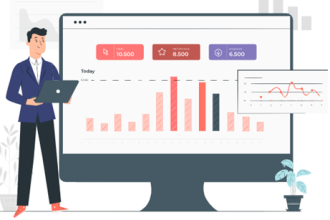RFID is identified and considered one of the most significant innovations in a constantly changing and evolving retail environment for which efficiency is always a key priority and cost savings a requirement. It is useful to companies as it enables them to improve organization efficiency, manage stocks, and reduce costs. This blog tries to uncover the various dimensional gains of RFID in retail and its contribution towards increasing effectiveness, decreasing losses, and managing resources more effectively.
Understanding RFID Technology: A Primer
Based on the usage of RF signals, RFID is an innovative technology for identifying items with RFID tags or labels. Such tags include electronically stored information that can be read wirelessly using an RFID reader or scanner. Compared to other barcode technologies, RFID allows quick and contactless tagging of objects, making it relevant for retail and many others.
Key Components of RFID Systems
1. RFID Tags: These are miniature electronic gadgets with barcode labels that are affixed to products, containers, or assets.
2. RFID Readers/Scanners: These devices transmit radio waves and, in the same process, receive data from RFID tags in the surrounding area.
3. RFID Middleware: This software layer interfaces with RFID readers, collects data, and forwards the collected data to enterprise systems and current business processes.
4. RFID Software and Analytics: These tools help retailers decode RFID information, understand inventory movements, and check stock rates to manage operations effectively.
Benefits of RFID in Retail
1. Enhanced Inventory Accuracy: Through RFID, inventory is tracked in real-time across the supply chain, thus reducing cases of stock-out, overstock, and errors. When used in managing the stocks, retailers can avoid stocking obsolete products, control for the disappeared products, and ensure they meet the customers’ orders.
2. Improved Operational Efficiency: The following basic applications are among some operational functions:
- Receiving and Replenishment
- Picking
- Cycle Counting.
Automated data capture on stock and inventory movement enables retail firms to enhance their operational methods, minimize errors that may arise during manual operation, and allocate resources at the optimal time.
3. Enhanced Loss Prevention: RFID plays a crucial role in loss prevention efforts by enabling retailers to identify and mitigate theft, shrinkage, and inventory discrepancies. By implementing RFID-enabled anti-theft solutions, such as electronic article surveillance (EAS) systems and RFID-based inventory tracking, retailers can deter theft, improve security, and minimize financial losses.
4. Optimized Supply Chain Management: RFID provides real-time value chain tracking, which allows retailers to follow the movement of the goods from the supplier’s end up to the stores. When RFID data is used for demand forecasting, supplier collaboration, and logistics optimization, retailers benefit from reduced lead time, minimum stockout, and enhanced supply chain operation.
5. Enhanced Customer Experience: RFID delivers the grocer and other retailers’ value-added convenient shopping experience to consumers. Check-out activities can be optimized, the waiting time can be minimized, and hence, customer satisfaction can be improved through RFID item-level tagging, self-check-out counters, and touch screens.
In conclusion, RFID technology can be regarded as a breakthrough for retail companies because it has the potential to produce accurate records of the inventory within a reasonable time span, and cost advantage. If used effectively, RFID offers several benefits to retail businesses in areas such as inventory tracking, loss control, replenishment of stock, and customer relations, hence boosting the retail firms’ portfolio, relevance, and competitiveness. Thus, adapting RFID as the retail format changes will become critical for companies to capture and serve the market demand and generate value for customers, shareholders, and stakeholders.















